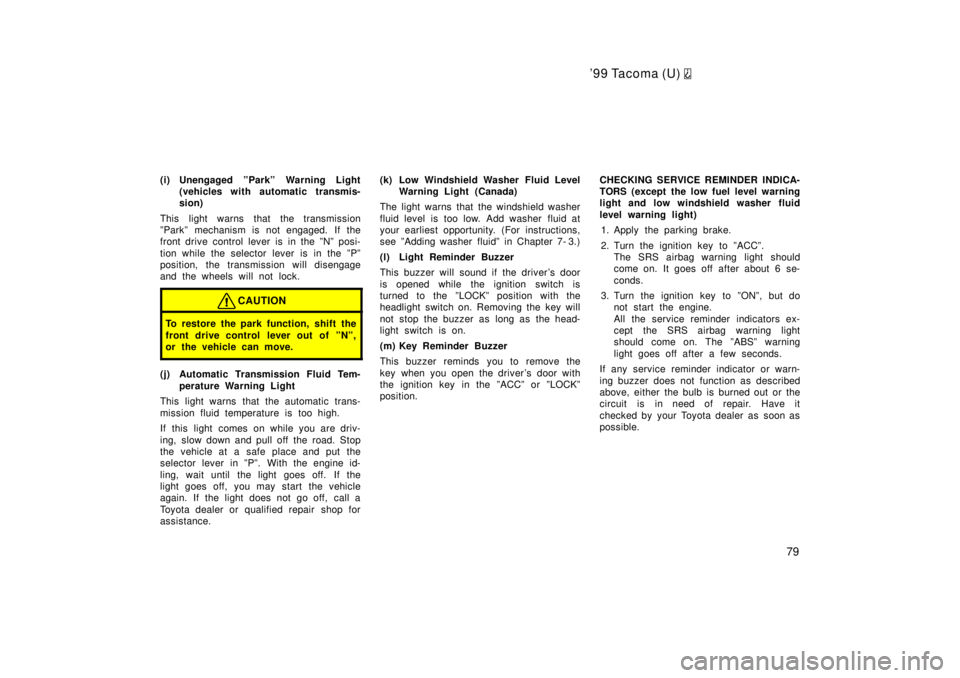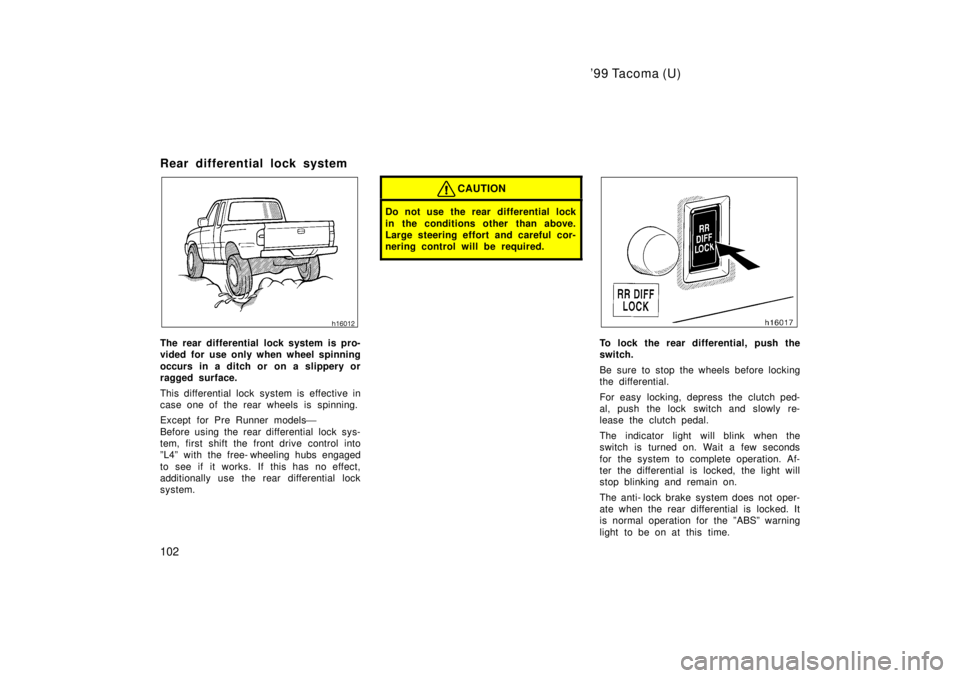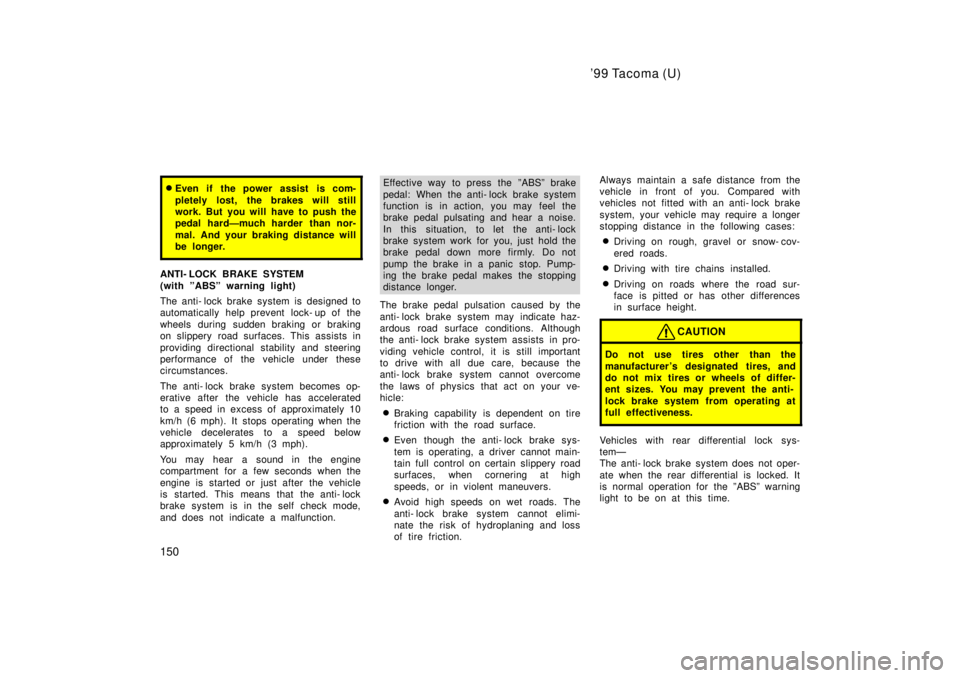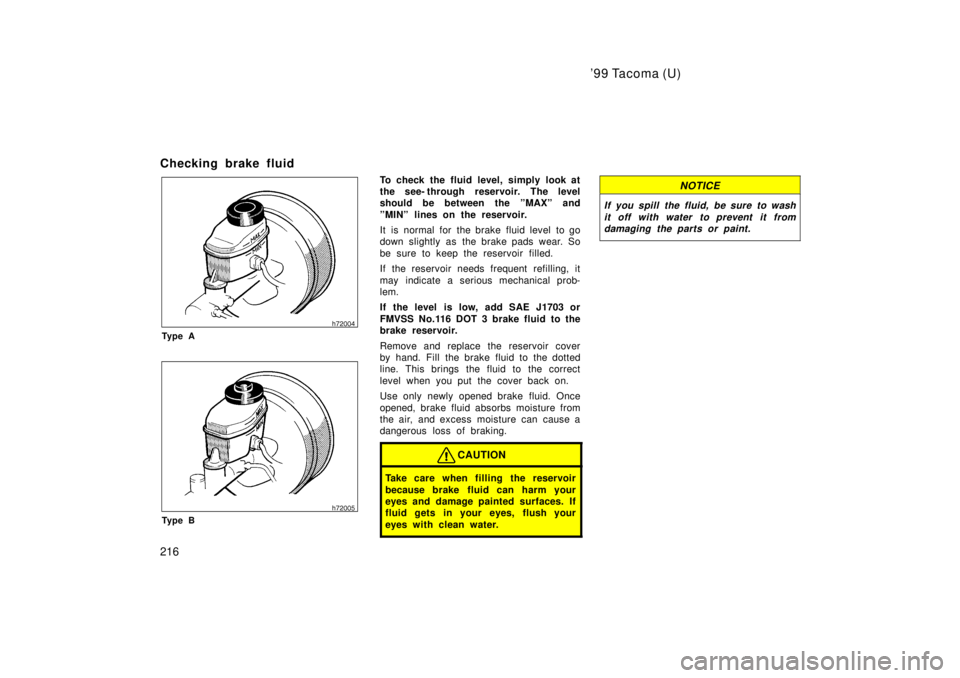1999 TOYOTA TACOMA ABS
[x] Cancel search: ABSPage 39 of 247

'99 Tacoma (U)
39
In a severe frontal impact, sensors detect
deceleration and the system triggers the
airbag inflators. Then a chemical reaction
in the inflators momentarily fills the air-
bags with non- toxic gas to help restrain
the forward motion of the occupants.
When the airbags inflate, they produce a
fairly loud noise and release some smoke
and residue along with non- toxic gas. This
does not indicate a fire. This gas is nor-
mally harmless, however, for those who
have delicate skin, it may cause minor
skin irritation. Be sure to wash off any
residue as soon as possible to prevent
minor skin irritation.
Deployment of the airbags happens in a
fraction of a second, so the airbags must
inflate with considerable force. While the
system is desi
gned to reduce serious inju-
ries, it may also cause minor burns or
abrasions and swellings.
Parts of the airbag module (steering wheel
hub, dashboard) may be hot for several
minutes, but the airbags themselves will
not be hot. The airbags are designed to
inflate only once. A crash severe enough to inflate the air-
bags may break the windshield as the
vehicle buckles. In vehicles with a pas-
senger airbag the windshield may also be
damaged by absorbing some of the force
of the inflating airbag.
CAUTION
�
The SRS airbag system is designed
only as a supplement to the prima-
ry protection of the driver side and
front passenger side seat belt sys-
tems. The front seat occupants can
be killed or seriously injured by an
inflating airbag if they do not wear
the available seat belts. During sud-
den braking just before a collision,
an unrestrained driver or front pas-
senger can move forward into direct
contact with or close proximity to
the airbag which may then deploy
during the collision. To obtain maxi-
mum protection in an accident, the
driver and all passengers in the ve-
hicle must wear their seat belts.
Wearing a seat belt during an acci-
dent reduces the chances of death
or serious injuries or being thrown
out of the vehicle. For instructions
and precautions concerning the seat
belt system, see ºSeat beltsº in this
chapter.
Page 78 of 247

'99 Tacoma (U)
78
NOTICE
Do not drive the vehicle with the warning light onÐeven for one block.It may ruin the engine.
(e) Malfunction indicator lamp
This lamp comes on in the following
cases.
a. The fuel tank is completely empty. (See
ºFuel gaugeº in Chapter 1- 5 for instruc-
tions.)
b. The fuel tank cap is not tightened se-
curely. (See ºFuel tank capº in Chapter
1- 2 for instructions.)
c. There is a problem somewhere in your
engine or automatic transmission electrical
system.
If it comes on while you are driving in
case c, have your vehicle checked/re-
paired by your Toyota dealer as soon as
possible. (f) Low Fuel Level Warning Light
This light comes on when the fuel level
in the tank becomes nearly empty. Fill up
the tank as soon as possible.
On inclines or curves, due to the move-
ment of fuel in the tank, the low fuel level
warning light may come on earlier than
usual.
(g) ºABSº Warning Light
This light warns that there is a problem
somewhere in your anti- lock brake sys-
tem.
If the light comes on while you are driv-
ing, have your vehicle checked by your
Toyota dealer as soon as possible.
The light will come on when the ignition
key is turned to the ºONº position. After
a few seconds, the light will go off.
When the ºABSº warning light is on (and
the brake system warning light is off), the
brake system operates conventionally but
anti- lock brake system is not assisting
brake performance so that the wheels can
lock- up during sudden braking or braking
on slippery road surfaces.Vehicles with rear differential lock sys-
temÐ
The anti- lock brake system does not oper-
ate when the rear differential is locked. It
is normal operation for the ºABSº warning
light to be on at this time.
(h) SRS Airbag Warning Light
This light will come on when the igni-
tion key is turned to the ºACCº or
ºONº position. After about 6 seconds,
the light will go off. This means the
system of the airbag and front seat belt
pretensioners are operating properly.
The warning light system monitors the air-
bag sensor assembly, seat belt pretension-
er assembly, inflators, warning light, inter-
connecting wiring and power sources.
If either of the following conditions occurs,
this indicates a malfunction somewhere in
the parts monitored by the warning light
system. Contact your Toyota dealer as
soon as possible to service the vehicle.
� The light does not come on when the
ignition key is turned to the ºACCº or
ºONº position or remains on.
� The light comes on or flashes while
driving.
Page 79 of 247

'99 Tacoma (U)
79
(i) Unengaged ºParkº Warning Light
(vehicles with automatic transmis-
sion)
This light warns that the transmission
ºParkº mechanism is not engaged. If the
front drive control lever is in the ºNº posi-
tion while the selector lever is in the ºPº
position, the transmission will disengage
and the wheels will not lock.
CAUTION
To restore the park function, shift the
front drive control lever out of ºNº,
or the vehicle can move.
(j) Automatic Transmission Fluid Tem- perature Warning Light
This light warns that the automatic trans-
mission fluid temperature is too high.
If this light comes on while you are driv-
ing, slow down and pull off the road. Stop
the vehicle at a safe place and put the
selector lever in ºPº. With the engine id-
ling, wait until the light goes off. If the
light goes off, you may start the vehicle
again. If the light does not go off, call a
Toyota dealer or qualified repair shop for
assistance. (k) Low Windshield Washer Fluid Level
Warning Light (Canada)
The light warns that the windshield washer
fluid level is too low. Add washer fluid at
your earliest opportunity. (For instructions,
see ºAdding washer fluidº in Chapter 7- 3.)
(l) Light Reminder Buzzer
This buzzer will sound if the driver 's door
is opened while the ignition switch is
turned to the ºLOCKº position with the
headlight switch on. Removing the key will
not stop the buzzer as long as the head-
light switch is on.
(m) Key Reminder Buzzer
This buzzer reminds you to remove the
key when you open the driver 's door with
the ignition key in the ºACCº or ºLOCKº
position. CHECKING SERVICE REMINDER INDICA-
TORS (except the low fuel level warning
light and low windshield washer fluid
level warning light)
1. Apply the parking brake.
2. Turn the ignition key to ºACCº. The SRS airbag warning light should
come on. It goes off after about 6 se-
conds.
3. Turn the ignition key to ºONº, but do not start the engine.
All the service reminder indicators ex-
cept the SRS airbag warning light
should come on. The ºABSº warning
light goes off after a few seconds.
If any service reminder indicator or warn-
ing buzzer does not function as described
above, either the bulb is burned out or the
circuit is in need of repair. Have it
checked by your Toyota dealer as soon as
possible.
Page 102 of 247

'99 Tacoma (U)
102
Rear differential lock system
The rear differential lock system is pro-
vided for use only when wheel spinning
occurs in a ditch or on a slippery or
ragged surface.
This differential lock system is effective in
case one of the rear wheels is spinning.
Except for Pre Runner models
'
Before using the rear differential lock sys-
tem, first shift the front drive control into
ºL4º with the free- wheeling hubs engaged
to see if it works. If this has no effect,
additionally use the rear differential lock
system.
CAUTION
Do not use the rear differential lock
in the conditions other than above.
Large steering effort and careful cor-
nering control will be required.
To lock the rear differential, push the
switch.
Be sure to stop the wheels before locking
the differential.
For easy locking, depress the clutch ped-
al, push the lock switch and slowly re-
lease the clutch pedal.
The indicator light will blink when the
switch is turned on. Wait a few seconds
for the system to complete operation. Af-
ter the differential is locked, the light will
stop blinking and remain on.
The anti- lock brake system does not oper-
ate when the rear differential is locked. It
is normal operation for the ºABSº warning
light to be on at this time.
Page 150 of 247

'99 Tacoma (U)
150
� Even if the power assist is com-
pletely lost, the brakes will still
work. But you will have to push the
pedal hardÐmuch harder than nor-
mal. And your braking distance will
be longer.
ANTI- LOCK BRAKE SYSTEM
(with ºABSº warning light)
The anti- lock brake system is designed to
automatically help prevent lock- up of the
wheels during sudden braking or braking
on slippery road surfaces. This assists in
providing directional stab ility and steering
performance of the vehicle under these
circumstances.
The anti- lock brake system becomes op-
erative after the vehicle has accelerated
to a speed in excess of approximately 10
km/h (6 mph). It stops operating when the
vehicle decelerates to a speed below
approximately 5 km/h (3 mph).
You may hear a sound in the engine
compartment for a few seconds when the
engine is started or just after the vehicle
is started. This means that the anti- lock
brake system is in the self check mode,
and does not indicate a malfunction.
Effective way to press the ºABSº brake
pedal: When the anti- lock brake system
function is in action, you may feel the
brake pedal pulsating and hear a noise.
In this situation, to let the anti- lock
brake system work for you, just hold the
brake pedal down more firmly. Do not
pump the brake in a panic stop. Pump-
ing the brake pedal makes the stopping
distance longer.
The brake pedal pulsation caused by the
anti- lock brake system may indicate haz-
ardous road surface conditions. Although
the anti- lock brake system assists in pro-
viding vehicle control, it is still important
to drive with all due care, because the
anti- lock brake system cannot overcome
the laws of physics that act on your ve-
hicle: � Braking capab ility is dependent on tire
friction with the road surface.
� Even though the anti- lock brake sys-
tem is operating, a driver cannot main-
tain full control on certain slippery road
surfaces, when cornering at high
speeds, or in violent maneuvers.
� Avoid high speeds on wet roads. The
anti- lock brake system cannot elimi-
nate the risk of hydroplaning and loss
of tire friction. Always maintain a safe distance from the
vehicle in front of you. Compared with
vehicles not fitted with an anti- lock brake
system, your vehicle may r
equire a longer
stopping distance in the following cases:
� Driving on rough, gravel or snow- cov-
ered roads.
� Driving with tire chains installed.
� Driving on roads where the road sur-
face is pitted or has other differences
in surface height.
CAUTION
Do not use tires other than the
manufacturer 's designated tires, and
do not mix tires or wheels of differ-
ent sizes. You may prevent the anti-
lock brake system from operating at
full effectiveness.
Vehicles with rear differential lock sys-
temÐ
The anti- lock brake system does not oper-
ate when the rear differential is locked. It
is normal operation for the ºABSº warning
light to be on at this time.
Page 151 of 247

'99 Tacoma (U)
151
Ty p e A
Ty p e BºABSº warning light
This light comes on when the ignition key
is turned to the ºONº position. After a few
seconds, the light will go off.
If any of the following conditions occurs,
this indicates a malfunction somewhere in
the parts monitored by the warning light
system. Contact your Toyota dealer as
soon as possible to service the vehicle.
� The light does not come on as de-
scribed above, or remains on.
� The light comes on while driving.
Vehicles with rear differential lock
systemÐ � The light comes on while driving with
the rear differential unlocked.
� The light does not comes on with the
rear differential locked.
� The system comes into operation with
the rear differential locked. Even if the anti- lock brake system should
fail, the brake system will still operate
conventionally. However, when the ºABSº
warning light is on (and the brake system
warning light is off), the anti- lock brake
system is not assisting brake performance
so that the wheels can lock- up during
sudden braking or braking on slippery
road surfaces. Have your vehicle checked
by your Toyota dealer as soon as pos-
sible.
Page 167 of 247

'99 Tacoma (U)
167
�
Be careful when passing other ve-
hicles. Passing requires considerable
distance. After passing a vehicle, do
not forget the length of your trailer and
be sure you have plenty of room be-
fore changing lanes.
� In order to maintain engine braking effi-
ciency, do not use fifth gear (manual
transmission) or overdrive (automatic
transmission).
� Because of the added load of the trail-
er, your vehicle's engine may overheat
on hot days (at temperatures over305C [85 5F]) when going up a long or
steep grade with a trailer. If the engine
coolant temperature gauge indicates
overheating, immediately turn off the air
conditioning (if in use), pull off the road
and stop in a safe spot. Refer to ºIf
your vehicle overheatsº in Part 4 of
this manual. �
Always place wheel blocks under both
the vehicle and trailer wheels when
parking. Apply the parking brake firmly.
Put the transmission in ºPº (automatic)
or in first or reverse (manual). Avoid
parking on a slope with a trailer, but
if it cannot be avoided, do so only
after performing the following:
1. Apply the brakes and hold.
2. Have someone place wheel blocks un- der both the vehicle and trailer wheels.
3. When the wheel blocks are in place, release your brakes slowly until the
blocks absorb the load.
4. Apply the parking brake firmly.
5. Shift into first or reverse (manual) or ºPº (automatic) and turn off the engine. When restarting out after parking on a
slope:
1. With the transmission in ºPº position (automatic) or the clutch pedal de-
pressed (manual), start the engine.
(With an automatic transmission, be
sure to keep the brake pedal de-
pressed.)
2. Shift into gear.
3. Release the parking brake (also foot brake on automatic transmission ve-
hicles) and slowly pull or back away
from the wheel blo cks. Stop and apply
your brakes.
4. Have someone retrieve the blo cks.
Page 216 of 247

'99 Tacoma (U)
216
Checking brake fluid
Ty p e A
Ty p e B
To check the fluid level, simply look at
the see- through reservoir. The level
should be between the ºMAXº and
ºMINº lines on the reservoir.
It is normal for the brake fluid level to go
down slightly as the brake pads wear. So
be sure to keep the reservoir filled.
If the reservoir needs frequent ref
illing, it
may indicate a serious mechanical prob-
lem.
If the level is low, add SAE J1703 or
FMVSS No.116 DOT 3 brake fluid to the
brake reservoir.
Remove and replace the reservoir cover
by hand. Fill the brake fluid to the dotted
line. This brings the fluid to the correct
level when you put the cover back on.
Use only newly opened brake fluid. Once
opened, brake fluid absorbs moisture from
the air, and excess moisture can cause a
dangerous loss of braking.
CAUTION
Take care when filling the r eservoir
because brake fluid can harm your
eyes and damage painted surfaces. If
fluid gets in your eyes, flush your
eyes with clean water.
NOTICE
If you spill the fluid, be sure to wash
it off with water to prevent it fromdamaging the parts or paint.